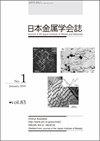从含有铂族金属的溶液中回收钌
IF 0.4
4区 材料科学
Q4 METALLURGY & METALLURGICAL ENGINEERING
引用次数: 1
摘要
采用氧化精馏法从含铂族金属的溶液中分离钌。该方法将钌氧化为四氧化钌(RuO4)。然后从盐酸(HCl)溶液中蒸馏和回收RuO4。本研究以溴酸钠(NaBrO3)为氧化剂,考察了将Ru转化为RuO4所需的NaBrO3的用量。在不同条件和温度下,通过添加氯化铵(NH4Cl),将HCl溶液中的钌析出为钌铵络合盐。研究了沉淀条件与沉淀盐性能的关系。对沉淀盐热解制得的钌粉的纯度进行了分析。(doi: 10.2320 / jinstmet.JE201606)本文章由计算机程序翻译,如有差异,请以英文原文为准。
Recovery of ruthenium from a solution containing platinum group metals
The oxidation–distillation method was used to separate ruthenium (Ru) from a solution containing platinum group metals. In this method, Ru was oxidized to ruthenium tetraoxide (RuO4). The RuO4 was then distilled and recovered from a hydrochloric acid (HCl) solution. In this study, sodium bromate (NaBrO3) was used as the oxidizer, and the amount of NaBrO3 needed to convert Ru to RuO4 was investigated. The Ru in the HCl solution was precipitated as an ammonium ruthenium complex salt by addition of ammonium chloride (NH4Cl) under various conditions and temperatures. The relationship between the precipitation conditions and the properties of the precipitated salts was investigated. The purity of the Ru powder, obtained by pyrolysis of the precipitated salt, was also analyzed. [doi:10.2320/jinstmet.JE201606]
求助全文
通过发布文献求助,成功后即可免费获取论文全文。
去求助
来源期刊

Journal of The Japan Institute of Metals
工程技术-冶金工程
CiteScore
0.70
自引率
0.00%
发文量
27
审稿时长
6-12 weeks
期刊介绍:
Information not localized
 求助内容:
求助内容: 应助结果提醒方式:
应助结果提醒方式:


